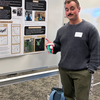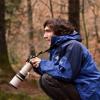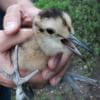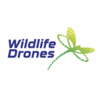Sensors already equip a range of tools to enhance monitoring capacity for conservation. Some of the higher bandwidth technologies, like camera traps and acoustic monitoring systems, have been essential elements of the conservation toolkit for decades, and thus have enough users that we've created dedicated WILDLABS groups to address them. But a whole range of lower bandwidth sensors beyond these core technologies are being increasingly integrated into conservation monitoring systems, and offer rich new insights into the wildlife and ecosystems we're all working to protect. As with many technologies, cost and access have historically been challenges to the adoption of new sensors, but with low-cost and open-source solutions on the rise, we're excited to see what the future of this space holds.
Getting Started with Sensors:
- Watch Shah Selbe's Tech Tutors episode on scaling FieldKit, an open-source conservation sensor toolbox, from a project to a successful conservation tech product.
- Check out our Virtual Meetup about Low-Cost, Open-Source Solutions in conservation tech, including a talk by Alasdair Davies on the Arribada Initiative's work with thermal sensors in early warning systems.
- For a more in-depth introduction, watch the first video in our datalogger mini-series: Freaklabs: How do I get started with Arduino?
In this group, you'll meet others who are using and innovating diverse sensors in their work, discuss ways to make sensors more effective & accessible for conservationists, learn about what sensors are already helping us accomplish in the field, and have the opportunity to ask and answer questions. Join this group to get started!
Header image: Emma Vogel, University of Tromsø
No showcases have been added to this group yet.
I am a scientist with research background in evolutionary-ecological genomics and have impact at the senate level to prevent a government viral biocontrol release. UK based and looking to connect with passionate dreamers ready to shift paradigms
- 0 Resources
- 3 Discussions
- 9 Groups
Woodland Park Zoo

- 0 Resources
- 5 Discussions
- 8 Groups
- 0 Resources
- 0 Discussions
- 14 Groups
Zoological Society London (ZSL)
Technical Project Manager in ZSL's Conservation Technology Unit



- 2 Resources
- 26 Discussions
- 7 Groups
finding ecological solutions using sound and conservation tech
- 0 Resources
- 0 Discussions
- 4 Groups
Currently a data scientist in industry working on mechanistic models of risk, previously worked on modeling coral reefs. I am interested in the potential for emerging technologies and new ideas to help us solve environmental crises.
- 0 Resources
- 0 Discussions
- 14 Groups
Fauna & Flora
- 0 Resources
- 3 Discussions
- 10 Groups
- @Phillip_Swart
- | He
I'm a conservationist working in the Vulture conservation space in South Africa with a huge passion for technology.
- 0 Resources
- 0 Discussions
- 17 Groups
Data Scientist/AI Engineer, Birdwatcher, Trail Runner: here to learn about conservation tech & contribute where I can.
- 0 Resources
- 0 Discussions
- 11 Groups
- @ctjack1109
- | He/Him
I am a graduate student at Purdue University developing low-cost IoT technology to measure wetland methane emissions. This, paired with my undergraduate education in Wildlife and Fisheries Resources, has me naturally drawn to advanced tech coupled with conservation issues.
- 0 Resources
- 0 Discussions
- 9 Groups
- @diego_ellis_soto
- | he/him
University of California & California Academy of Sciences
Biodiversity |Technology | Socio-Ecological Systems | Wildlife Ecology | Remote Sensing | Conservation | K12STEM-education | Music | diegoellissoto.org
- 0 Resources
- 0 Discussions
- 20 Groups
- @Alawa
- | She/Her
Passionate wildlife and biodiversity conservationist
- 0 Resources
- 0 Discussions
- 24 Groups
Technology is rapidly changing the way communities monitor wildlife movement and prevent or mitigate human-wildlife conflict. This case study from Appiko delves into field testing of the open source sensor warning...
25 February 2020
The Arribada Initiative is back with an update on their thermal elephant alert system which aims to reduce human-elephant conflict (HEC). The success of their system rests on the ability of a camera to accurately...
17 February 2020
Applications are now open for a second round of the £10 million UK Seafood Innovation Fund to transform the future landscape of the seafood industry.
11 February 2020
Microbial fuel cells, developed by Plant-powered Camera Trap Challenge winners Plant-E, have been used successfully with Xnor.ai's energy harvesting camera technology to capture what are thought to be the world's first...
15 October 2019
Article
How do we actually know a whale weighs 40 tonnes? After all, we can’t exactly capture an animal the size of a bus and simply put it on a scale. Fredrik Christiansen explains their new, non-invasive way of weighing...
9 October 2019
Article
In the past six months Instant Detect 2.0 has physically emerged, with the first prototype systems built and ready for testing at the start of April. The ZSL team is now well into their optimisation and hardening phase...
3 September 2019
The European Space Agency’s “Environmental Crimes” thematic call offers support and funding of up to €60,000 per activity to companies looking to develop services tackling illegal water, air and land polution using...
22 August 2019
Sharing failure, tech support for conservation, roaming mentors, conservation tech hype cycles and developing new road maps - participants in our tech workshops at ICCB 2019 shared an abundance of ideas for how to shape...
21 August 2019
Article
In this From the Field interview, we talk to Melissa Schiele, a tech whiz, marine ecologist, and conservationist at the Zoological Society of London. She shares with us about her work helping to develop the first-ever...
10 June 2019
The WILDLABS TECH HUB is supporting technology solutions tackling the illegal wildlife trade, in collaboration with the Foreign & Commonwealth Office, Digital Catapult, Satellite Applications Catapult, Amazon Web...
4 June 2019
Ol Pejeta Conservancy partners with conservation and technology organisations to kick-start a research and innovation centre for wildlife conservation
31 May 2019
FLIR announces the launch of their Conservation Discount Program, which offers projects the opportunity to qualify for a 30% discount on select thermal, visible, and maritime products. Share your conservation plan and...
23 May 2019
August 2025
event
September 2025
event
March 2026
July 2024
April 2024
event
17 Products
Recently updated products
121 Products
3 R&D Projects
84 Organisations
Recently updated products
Recently updated R&D Projects
Recently updated organisations
| Description | Activity | Replies | Groups | Updated |
|---|---|---|---|---|
| That's great Jason. I think your approach can be very successful. I'm a little bit familiar with Wild Book through my contacts at IBEIS, who I believe you... |
|
Sensors | 9 years 5 months ago | |
| I was amused to read about a flock of pigeons just released in London to tackle pollution. The flock was equipped with pollution... |
|
Sensors | 9 years 5 months ago |
Interest in group order of ETag RFID readers
5 December 2019 8:05pm
How do I build bespoke conservation technology?
20 July 2020 12:00am
Training Opportunity: Durrell Conservation Academy
 Durrell Conservation Academy
Durrell Conservation Academy
16 July 2020 12:00am
How do I repair my camera traps?
13 July 2020 12:00am
Kākāpō Dreaming: A Wildlife Drones Adventure
8 July 2020 12:00am
Era of the Condor: A Species' Future in Recovery (Part 3)
2 July 2020 12:00am
Era of the Condor: A Species' Future in Recovery (Part 2)
25 June 2020 12:00am
Seeking research projects related to monitoring wildlife behavior
20 June 2020 3:34pm
22 June 2020 8:54pm
Hi Ben!
I think we've had correspondence on Twitter in the past, but can't remember for sure... Anyways, I'm a primatology PhD student and do fieldwork in Madagascar studying lemurs (specifically Ranomafana National Park). My dissertation is on lemur vocal communication, but I am doing an applied chapter focused on passive acoustic monitoring as well. I've tested out a bunch of different PAM devices (ARU's-autonomous recording units) e.g., SongMeter, Swift, AudioMoth and am currently annotating call files and prepping a training dataset that I hope to begin using with an ML model to identify species-specific calls. Vocals are a great use-case with behavior and tech as you can sometimes ID contexts, individuals, etc based on acoustic structure or usage which would be really cool (albeit very complicated) to incorporate.
Also have some experience with camera-traps, and the area I work in in Mada is part of the TEAM network so I'm hoping to incorporate camera-traps and ARUs in the same area. I work with local researchers and students (via the Malagasy-run Centre ValBio research station) and am looking to develop community-led initiatives as well so I've got the low-cost, open-source interest as well.
I'll stop typing an essay now, but definitely would love to chat!! Feel free to message me on Twitter or email me (cbatist@gradcenter.cuny.edu).
23 June 2020 1:56am
I'd love to chat more! I'll be reaching out soon!
From Autonomous Cars to Aqualink: Developing a Reef Monitoring System
9 June 2020 12:00am
Event: Arm’s AI Virtual Tech Sessions
 Arm
Arm
9 June 2020 12:00am
Innovator Interview: Hack the Poacher
4 June 2020 12:00am
Webinar: The Next Generation Of Animal Telemetry
 BOEM
BOEM
1 June 2020 12:00am
Competition: 2020 Hackaday Prize
26 May 2020 12:00am
Grassroots Innovations for Wildlife Conservation
19 May 2020 12:00am
WILDLABS Tech Tutors: Season One
19 May 2020 12:00am
12th International Forum on Illegal, Unreported and Unregulated Fishing
 Chatham House
Chatham House
14 May 2020 12:00am
sound loop devise
26 April 2020 1:29pm
12 May 2020 4:07pm
I reckon if you could get down to a power consumption of 2-3Ah per day like our system had then a battery of 20Ah is suitable for a week and you wouldn't need inverters and solar panels etc. I agree that in your environment everything will struggle with being powered for 24hrs. I rarely have that problem to contend with! Will have a look at a temperature test of our design over the Summer and will share the details in a blog if it looks like it will prove a solution for all environments.
12 May 2020 7:14pm
Hi Eric, I think you could do away with an inverter, and instead use something like a DC-DC step-down (sometimes called a 'buck') converter. The solar and battery system is 12VDC correct? Chances are that the MP3 player wall charger is pumping out something like 5VDC (it should be written on the side of the plug)? Something like this would work: https://www.altronics.com.au/p/z6338-dc-dc-converter-module-3.5-35v-input-5-56v-output/
or if it is a 12V battery as I suspect, virtually any 'car' charger for a phone would do (just as I suspect the powerbank will). Hopefully, a large capacity powerbank is enough anyway, and you don't even need solar...
13 May 2020 12:39pm
Yes im hoping the power bank and a few extra mp3s will get it done this year. will look into a better system this winter now that I have some help:)
Era of the Condor: A Species' Future in Recovery
5 May 2020 12:00am
Notification systems for trap activation
10 January 2019 5:30am
4 May 2020 2:05am
Hi Rahid,
Thanks for your reply. In answer to your questions:
#1
There would be no external power (or cell phone reception) available at any of the node? The nodes would need to be completely autonomous.
#2
Total number of nodes would likley be in the range of 100–200 within a project area.
#3
The maximum distance between two nodes would likely be 5 km.
#4
All i want to transmit is an alert to say whether a trap has been activated or not. No video is required.
Many thanks,
Andrew
4 May 2020 3:00am
Ok, we can customize a solution for you, but probably won't be able to get this out to you for around 3-4 months.
RF and mesh is our domain. We can guarantee NLOS at well over 20 km+.
5KM in not a large distance. Not sure if LoRa can handle 200 nodes or work in the bush --- trees are the enemy of anything above 300 MHz.
I'm all for using HF (below 30MHz) or tactical VHF (30-108 MHz).
Would 1-1.6m antennas work?
---
I can email you a case study for a much more complex project that we did last December .
We were able to transmit video using 100KHz of bandwidth over a frequency of 30.5 MHz. Our moving car was traveling at 130 km/h and achieved a 64km+ distance from the base station --- we used 50% less bandwidth to transmit video than what an FM radio station uses to transmit tunes and other meta data. Our glass to glass (camera lense to monitor) latency was 24ms.
---
Our solutions don't require an expensive sattelite link or any phone network to work (although we can add those options).
What this means is that our radios will always work, come rain, come snow, et al. --- Satellite links are easily disrupted by a low cast / clouds , etc.
Our signals reflect and refract of the ground and the ionosphere to give you NLOS in any condition.
So a sensor based project of 200 nodes is no problem at all.
---
If waiting 3-4 months is not a big deal, then we can donate a few units to your project once we learn more about it.
---
4 May 2020 5:01am
Please see my edits above
Competition: iWildCam 2020
4 May 2020 12:00am
Mesh Powered Software Defined Radios
2 May 2020 7:13am
Call for Submissions – Arm Research Summit 2020
24 April 2020 12:00am
Talking Tracking with Xerius
23 April 2020 12:00am
#FieldKit50: Earth Day Giveaway
22 April 2020 12:00am
WILDLABS Tech Hub: WWF PandaSat
13 April 2020 12:00am
Locally-Brewed Conservation Technology from a Small Town in North Bengal
10 April 2020 12:00am
Connecting to MBARI's Deep-Sea Instruments
31 March 2020 12:00am
WILDLABS Community Call Recording: Rainforest X-PRIZE
30 March 2020 12:00am
Virtual Field Trip: Conservation Technology with Shah Selbe
24 March 2020 12:00am
Online Workshop: Conservation Technology
 Hack the Poacher
Hack the Poacher
23 March 2020 12:00am































23 July 2020 11:13am
Hi all,
Some ETAG rfid-readers are now avaible at https://www.labmaker.org/collections/earth-and-ecology/products/etag. The price is high, though: USD139.
Yvan